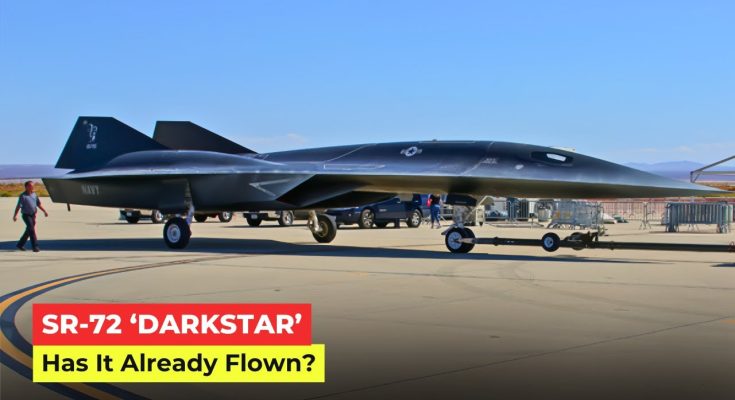The SR-72 Darkstar is a name that has piqued the curiosity of aviation enthusiasts, defense experts, and conspiracy theorists alike. Speculated to be the successor to the legendary SR-71 Blackbird, the SR-72 is believed to be a hypersonic spy plane capable of reaching speeds greater than Mach 5 (five times the speed of sound). While the U.S. Air Force has never officially confirmed the existence of the SR-72, rumors and reports suggest that it may have already taken to the skies in secret. The mystery surrounding the SR-72 continues to grow, leaving many to wonder if the hypersonic spy plane is already operational—or if it is still in the testing phase.
The SR-71 Legacy and the Need for Hypersonic Aircraft
The SR-71 Blackbird, retired in the 1990s, was an iconic and unmatched reconnaissance aircraft, capable of reaching speeds of over Mach 3 and flying at altitudes above 85,000 feet. While the SR-71 was a marvel of Cold War-era aviation, it was eventually retired due to aging technology and the development of satellite-based reconnaissance systems.
However, the need for high-speed reconnaissance and strike capabilities didn’t disappear with the SR-71’s retirement. The advent of hypersonic flight—flight speeds greater than Mach 5—promised to revolutionize aerial reconnaissance and strike missions, leading to speculation that the U.S. Air Force has been working on a successor to the SR-71. Enter the SR-72, a next-generation hypersonic plane that would make use of scramjet engines to achieve speeds far greater than any aircraft in history.
What Do We Know About the SR-72?
The SR-72 is widely believed to be a hypersonic unmanned aerial vehicle (UAV), designed to carry out intelligence, surveillance, and reconnaissance (ISR) missions. With hypersonic capabilities, it would be able to fly across vast distances at incredible speeds, gathering intelligence or potentially launching strikes before adversaries even had a chance to react. The key technology behind the SR-72’s design is its ability to reach Mach 6 or faster, allowing it to operate with near-immunity to contemporary air defense systems.
The SR-72’s likely propulsion system involves scramjet engines, which are designed to operate efficiently at hypersonic speeds. Unlike traditional jet engines, scramjets operate by compressing air entering the engine before it is ignited, making them capable of sustaining the high speeds needed for hypersonic flight. This technology has long been the subject of research, with various experimental aircraft, such as the X-51 Waverider, providing valuable insights into how scramjet engines might work in practice.
While official details about the SR-72 remain scarce, Lockheed Martin’s Skunk Works—the same division responsible for designing the SR-71—has been involved in the development of the SR-72. In fact, Lockheed Martin has publicly acknowledged its work on a hypersonic platform, referring to it as the “SR-72” in some of its promotional material.
Has the SR-72 Already Flown?
Despite a lack of official confirmation, there are persistent rumors that the SR-72 has already made test flights. In 2017, Lockheed Martin’s Skunk Works unveiled concept designs for the aircraft, leading many to believe that the project was progressing rapidly. Reports of secret tests and sightings of mysterious high-speed aircraft over military testing ranges have fueled speculation that the SR-72 is no longer just a concept.
In addition, there are unconfirmed reports of the SR-72 being tested using hypersonic drones or scale models. These tests could be a precursor to full-scale flights of the actual aircraft. Given the high level of secrecy surrounding the program, it’s possible that the SR-72 has already flown under the radar, both literally and figuratively, without public knowledge.
The Strategic Importance of the SR-72
The SR-72 could have immense strategic value in modern warfare. Its hypersonic speed would make it extremely difficult to intercept or track using current missile defense systems, making it a “first-strike” platform capable of reaching targets before enemy defenses can respond. Additionally, its ability to rapidly deploy and gather intelligence could revolutionize how reconnaissance missions are conducted.
The SR-72 would also be invaluable for countering emerging threats, such as advanced surface-to-air missile systems or anti-aircraft technologies that are increasingly common in adversarial nations. If it exists, the SR-72 could serve as a critical part of the U.S. Air Force’s arsenal, providing an edge in both reconnaissance and strategic operations.
Conclusion
The SR-72 Darkstar, if it exists, represents a huge leap in aviation technology. Its rumored hypersonic capabilities would allow it to operate in ways that were previously unimaginable, creating an unmatched advantage for the U.S. military. However, the aircraft’s mysterious nature and the lack of official information leave many questions unanswered. Has it already flown? Is it merely a concept in development, or is it waiting for the right moment to be revealed to the public? The truth remains elusive, but the possibility of an operational SR-72 remains one of the most exciting and tantalizing secrets in the world of modern military aviation.



